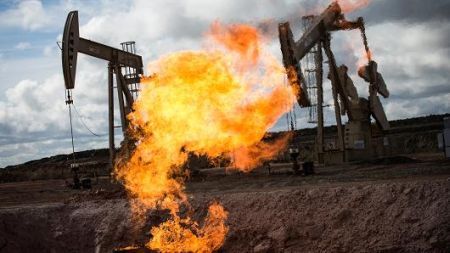
West Texas Intermediate fell for the third time in four days before a government report forecast to show U.S. crude stockpiles expanded and amid concern consumption in China may falter.
Futures in New York dropped as much as 0.8 percent as prices approached a technical level that signals gains may have been excessive. U.S. crude inventories increased for a sixth week to 363.6 million barrels, according to a Bloomberg News survey of analysts before Energy Information Administration data tomorrow. Equities in China, the world’s second-largest oil user, plunged the most since July on speculation a weaker property market will crimp growth.
“Prices have rallied further than perhaps the underlying supply-demand fundamentals would suggest,” said Hakan Kocayusufpasaoglu, chief investment officer at Archbridge Capital AG, a Zug, Switzerland-based hedge fund. “Demand growth is not phenomenally strong, and emerging markets, which have been the main driver of growth, are slowing down.”
WTI for April delivery slid as much as 80 cents to $102.02 a barrel in electronic trading on the New York Mercantile Exchange and was at $102.27 as of 9:34 a.m. London time. The contract rose 0.6 percent to $102.82 yesterday, the highest close since Feb. 20. The volume of all futures traded was about 9 percent below the 100-day average.
Brent for April settlement decreased as much as 59 cents, or 0.5 percent, to $110.05 a barrel on the London-based ICE Futures Europe exchange. The European benchmark crude was at a premium of $8.11 to WTI on ICE. The spread widened for a second day yesterday to close at $7.82.
Risky Lending
China’s central bank is draining funds from the financial system as lower money market rates signal ample supplies of yuan amid a government drive to clean up risky lending practices.
The Shanghai Composite Index dropped 2 percent after gaining as much as 0.5 percent, while the CSI 300, which tracks shares in Shanghai and Shenzhen, headed for a 4.7 percent decline over two days.
Citigroup Inc. raised its forecast for Brent crude in 2014 to $103 a barrel, from $93 previously, because of “tighter-than-expected global supply-demand balances and increasing pessimism over incremental supplies from Iran and Libya,” London-based analyst Seth Kleinman wrote in a report. Iranian output has been curbed by sanctions and Libyan exports by protests at terminals.
Relative Strength
WTI’s 14-day relative strength index is at about 65 today after climbing to a seven-month high of 74 on Feb. 20, according to data compiled by Bloomberg. A reading above 70 shows the market is overbought.
A major snowstorm will miss the U.S. Northeast even as temperatures across the Midwest are forecast to drop below zero Fahrenheit and reach the teens in New York this week.
Average temperatures at least 15 degrees below normal (8 Celsius) will spread across the Great Plains and Midwest through March 5, said Matt Rogers, the president of Commodity Weather Group LLC in Bethesda, Maryland. Readings may be 25 degrees below normal in Chicago, according to MDA Weather Services in Gaithersburg, Maryland.
WTI capped its sixth weekly advance on Feb. 21, the longest rally in a year, as cold weather boosted energy demand and stockpiles shrank at Cushing, the delivery point for New York-traded contracts. TransCanada Corp. began moving crude from the storage hub to Texas on the southern portion of its Keystone XL pipeline in January.
Fuel Supplies
U.S. distillate inventories, a category that includes heating oil and diesel, probably fell by 1.5 million barrels in the week ended Feb. 21, according to the median estimate of nine analysts surveyed by Bloomberg before the report from the EIA, the Energy Department’s statistical arm. That would be a seventh weekly decline.
Total crude stockpiles increased by 1.3 million barrels, the survey shows. Gasoline supplies are projected to have dropped by 1 million.
In Libya, the holder of Africa’s biggest crude reserves, production remained at 231,000 barrels a day, said Mohamed Elharari, a spokesman for National Oil Corp. The Sharara field, the nation’s second-largest, has been closed since Feb. 20.
Source: Bloomberg
We use cookies to improve your experience. By continuing to use our site, you accept our Cookies, Privacy Policy,Terms and Conditions. Close X